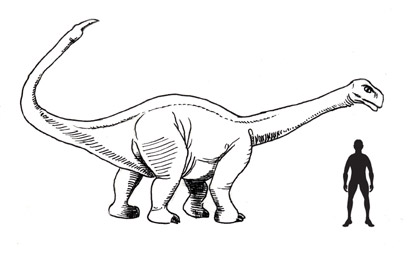Changing Views on Sauropods (New Research)
Changing Views on Sauropods – Long-necked Dinosaurs
The huge, long-necked sauropods such as Diplodocus and Brachiosaurus are extremely well known in popular culture but although many museums exhibit specimens of these enormous creatures, our level of scientific knowledge particularly the phylogeny of these creatures remains relatively poor. Thanks to recent discoveries of some seemingly transitional forms from prosauropods to the true sauropods, dinosaurs such as Lessemsaurus from Argentina and Chinshakiangosaurus from China for example, our understanding of the evolution of these animals is more complete.
The sauropods were a truly remarkable group of dinosaurs, with some of the oldest sauropod fossils dating from the beginning of the Jurassic and with the last titanosaurs surviving in the Americas and other parts of the Southern Hemisphere right up to the end of the Cretaceous, approximately 66 million years ago. Although these animals had their hey day in the Jurassic, no other type of herbivore has dominated terrestrial ecosystems quite like the sauropods. With their massive bulk, animals like Apatosaurus for instance could weigh in excess of 30 tonnes; they decimated the vegetation within an environment before moving on in vast herds to find fresh feeding areas.
Sauropods represent a truly unique group of animals, there is nothing alive today to compare with them and their size, power and myriad of forms are truly amazing. Most sauropods are classified into two distinct types, the Macronaria (big nostrils), nasal openings in skulls are bigger than the orbit (eye). Sauropods typical of the Macronaria group are animals such as Brachiosaurus and Camarasaurus.
To see a scale model of Brachiosaurus and other sauropod figures: Dinosaur Models and Toys.
The other main type of sauropod are the Diplodocoidea, animals such as Diplodocus and Seismosaurus. Some very bizarre forms of sauropod are known. For example, scientists know that a number of later sauropods (titanosaurs) were armoured, but also many of the lesser known sauropods also possessed body armour, scutes and even clubs on the ends of the tail.
Shunosaurus from the mid Jurassic of China had a club on the end of its tail. When the first fossils of this dinosaur were found in 1979, the tail was thought to have become damaged and the bones had not healed properly and had become infected, producing this abnormal growth in the single specimen discovered. Several fully articulated fossil Shunosaurus are now known and all possess this club-like feature on the end of their tails. Scientists were able to conclude that the swollen tail of this dinosaur was not the result of an injury or disease (pathology), but this dinosaur possessed the equivalent of a medieval mace on the end of its tail.
An Illustration of Shunosaurus

Picture credit: Everything Dinosaur
To view a model of Shunosaurus and other figures in the Safari Ltd model collection: Wild Safari Prehistoric World.
This particular sauropod is estimated to have reached lengths in excess of 9 metres and it was one of the most common type of long-necked dinosaur found in what was a vast, Jurassic floodplain now being excavated at the Dashanpu quarry site.

